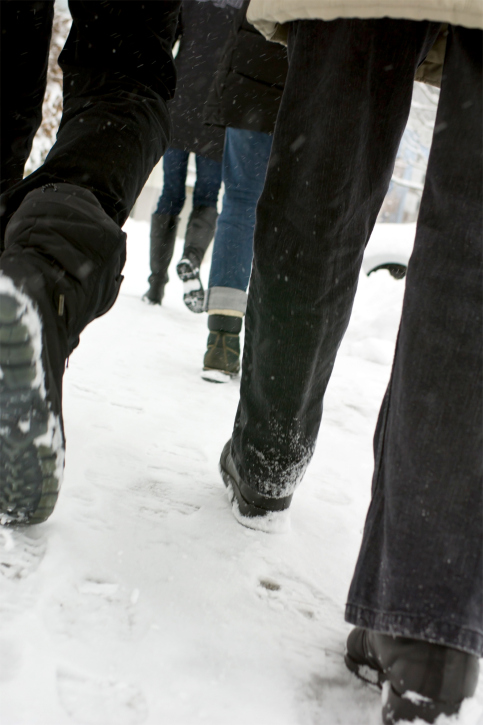When winter weather hits we all think we know what to do on that first frosty morning as the frozen parking lot greets us. However now would be a good time to remind folks of your winter weather work place safety plan. Here are some tips!
1. Create a winter weather watch and response team.
Appoint a team of employees to monitor the weather conditions. Select individuals who are early risers, good communicators, and could determine if snow and icy conditions would create hazardous conditions for your commuters. Identify to whom and where they should report slippery conditions.
Make sure you have an action plan in place for if they find ice in the parking lot or on the sidewalk leading into their building.
Bonus Winter Tip: Gather your winter weather watch team and plan ahead as to what you will do when that first flake begins to fall. If you already have a plan, review both your removal and/or snow safety plan with them. Encourage them to make improvements on these plans, especially if they were created more than a year ago. What have you learned or changed since then? Whatever you come up with communication is the key so be sure everyone understands the plan and how to respond. Share this with all employees, especially if it requires them to be involved.
2. Get regular winter updates.
Pick one person on your team to update a point person regarding the latest weather conditions. A good choice would be someone who may be traveling a distance to work, or who works at a different location than the point person. They should immediately relay storm warnings and weather updates to the point person so they can make early decisions for everyone involved, especially when the conditions could quickly become potentially dangerous.
3. Don’t forget your anti-slip footwear!
Remind employees to dress sensibly when it comes to footwear.
 Fashionable shoes may not be sensible when trekking the icy parking lot or sidewalk. Request they wear shoes with good traction to and from work, and consider carrying the more stylish footwear with them to put on when they arrive. Remind them to switch footwear again when going back outside as conditions may still be treacherous. Suggest a sturdy non skid shoe, anti-slip overshoes, ice walkers or other anti-slip footwear. Make sure you prioritize the needs of employees who frequently come and go from your work site. Consider providing or offering reimbursement allowances for those who are required to work out in the cold and snow.
Fashionable shoes may not be sensible when trekking the icy parking lot or sidewalk. Request they wear shoes with good traction to and from work, and consider carrying the more stylish footwear with them to put on when they arrive. Remind them to switch footwear again when going back outside as conditions may still be treacherous. Suggest a sturdy non skid shoe, anti-slip overshoes, ice walkers or other anti-slip footwear. Make sure you prioritize the needs of employees who frequently come and go from your work site. Consider providing or offering reimbursement allowances for those who are required to work out in the cold and snow.
Bonus Winter Tip: Emphasize that non slip foot wear does not usually include cowboy boots, sneakers, leather shoes and plastic-soled shoes.
4. Mark potentially “highly vulnerable” areas.
Identify walkways and other areas that may be covered up with snow or ice or that are routinely slippery problems.
You know them, the place water always puddles when it rains – this is a recipe for an icy mess. When covered with a thin layer of snow it’s a hidden hazard as well. Mark these spots before the storm with hazard markers and tackle them first when sprinkling ice melt or shoveling.
Bonus Winter Tip: Before you busy yourself with installing markers, check outdoor work areas or walkways for low spots and cracks. By repairing these spots or cracks now, you can prevent snow and ice from accumulating in these areas.
5. Get help from floor mats and “Wet Floor” signs.
Sometimes it’s just hard to distinguish a slippery floor from a dry one so make sure you have more than enough floor mats and “Wet Floor” signs.
Such seemingly small things can do a lot to prevent injuries. Just placing floor mats at entrances can reduce the tracking in of ice and snow. As for “Wet Floor” signs, just place them in areas that may cause slipping or falling.
Bonus Winter Tip: Regularly check mats and immediately replace those that have frayed or have curled-up edges. Stick to non-slip floor mats that have rubber padding. Make sure also to immediately replace or repair loose or damaged flooring to better prevent slips and falls. Frequent changing of soggy mats may be necessary in higher traffic areas. Be sure to have extras on hand for this purpose.
6. Let employees do their own sprinkling.
Place drums of rock salt, ice melt, or sand near entrances or throughout parking lots to encourage employees to take care of outdoor spots covered with ice or snow. Offer suggestions on the best use of the material by placing a placard or sign on the barrel or container. Take care to place these where they won’t be in the way of or damaged by your snow removal crew.
Bonus Winter Tip: You may want to substitute potassium-based de-icers for salt, as the latter can damage lawns, concrete, carpets and even floors which may receive salt debris as workers walk inside.
7. Ask for certificates.
Ask for certificates of insurance when you hire private contractors to remove snow in your workplace.
Plan ahead. Remember that it’s all about anticipation. That’s not to say that you should anticipate the worst, but by anticipating both the simplest and worst slips and falls that could happen to your workers this seas



